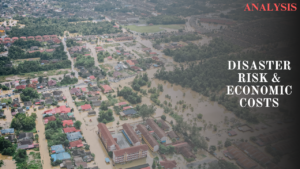Climate change is intensifying disasters globally, with India ranking among the most affected countries. With rising economic losses and vulnerability, India urgently needs proactive, localised disaster management strategies, resilient infrastructure, and tech-driven solutions. Strong public-private partnerships and community engagement are vital to mitigate risks and safeguard the nation’s future.
 Climate change is killing us in unimaginable ways at far more intensity and scale than the kind of responses we deploy to deal with the crisis. Almost all credible studies and reputed institutes indicate alarming levels of rise in climate disasters and natural calamities across the world. Despite global climate action efforts and some level of concerted efforts, economic implications of climate change are only deteriorating. The cost of climate disasters could most likely reach $145 billion in insured losses in the year 2025, as per a recent report by Swiss Re. This will be a jump by around 6% from 2024 which witnessed the insured financial losses of $137 billion. The same report also revealed that total losses from natural resources, including those not covered by insurance, reached a figure of about $318 billion last year. This is an increase from $292 billion in 2023.
Climate change is killing us in unimaginable ways at far more intensity and scale than the kind of responses we deploy to deal with the crisis. Almost all credible studies and reputed institutes indicate alarming levels of rise in climate disasters and natural calamities across the world. Despite global climate action efforts and some level of concerted efforts, economic implications of climate change are only deteriorating. The cost of climate disasters could most likely reach $145 billion in insured losses in the year 2025, as per a recent report by Swiss Re. This will be a jump by around 6% from 2024 which witnessed the insured financial losses of $137 billion. The same report also revealed that total losses from natural resources, including those not covered by insurance, reached a figure of about $318 billion last year. This is an increase from $292 billion in 2023.
If we zoom out a bit and put the spotlight back on India, which is the 7th highly vulnerable country in the world, climate disasters have only seen an increase. India particularly is facing unprecedented levels of disaster risks and related incidents in every region. And the reasons for the escalating disasters could be many, including our heavy reliance on agriculture, vast coastal areas, large population, changing weather patterns, geographical limitations, flood-prone regions, extreme heatwaves, growing risk of water shortage, etc. For instance, India suffered the loss of around $12 billion (more than Rs 1 lakh crore) in the economic losses due to natural calamities and escalating disaster risks in 2023 alone, as per reports. There has been systematic loss of money and worsening economic crisis due to climate-induced disasters. A past report by the UN revealed that India incurred the economic losses of $80 billion from natural disasters as a long-term impact of climate-induced disasters between 1998 and 2017. This proves that climate disasters are not something new that India is faced with, although it has been garnering an increasing level of attention now. Moreover, if you look at the most recent data for India in the Asia-Pacific context, you will find that the country accounted for 21% of the region’s $230 billion financial losses as a result of climate and weather related risks just between 2019 and 2023, as per the Asian Development Bank study.
 Climate scientists and experts have been warning of deadly consequences of climate change. Their fears with respect to the increasing intensity and frequency of extreme weather events and natural calamities have become frequent reality for many parts of the world, particularly India. It has been witnessing deadly heatwaves, ravaging floods, droughts, landslides, cyclones, earthquakes, wildfires, etc.
Climate scientists and experts have been warning of deadly consequences of climate change. Their fears with respect to the increasing intensity and frequency of extreme weather events and natural calamities have become frequent reality for many parts of the world, particularly India. It has been witnessing deadly heatwaves, ravaging floods, droughts, landslides, cyclones, earthquakes, wildfires, etc.
Data suggests 54 million people of 82 million disaster affected people in South Asia were from India. Moreover, India accounts for 21% of the 256 million people affected by disasters. This clearly means that India leads in economic losses at least in the South Asian region.
Around 80% of our total districts are highly climate vulnerable. Not just that, close to 58.6% of India’s landmass is at risk of earthquakes, as per the National Disaster Management Authority (NDMA). This crisis is becoming a monster because of a combination of reasons including, unplanned urbanisation, deforestation, climate change crisis, and unacceptable interventions with mother nature. Most of our disaster risk mitigation strategies and measures seem like a reaction and not a well-crafted response. What we are missing is a proactive approach and tailored responses to the climate change crisis for different regions, causing many disasters in different parts of the country.
We need to also focus on capacity building measures, hyper-local community engagement, implementing district-specific disaster management plans, and training the local population in climate adaptation. Moreover, serious focus should also be given to developing disaster resilient infrastructure that can withstand natural calamities. Other reasons for our challenges in disaster risk management pertain to limited or no communications to resolve issues quickly. There are different agencies and multiple levels of authorities from public and private sides facing challenges because of ineffective communication. Finally, the role of technology is critical in India’s Disaster Risk Reduction plans and aims. We need to use AI and technology more frequently than now to ensure early risk warnings, predictive plan preparations, long-term weather forecasting systems, and use of Geographic Information System (GIS) for risk assessment and real-time monitoring. We must enable public-private partnerships for knowledge-sharing on disaster risk mitigations. Tailored actions with long-term vision can only help us in minimising disaster risk and the consequential economic losses.
Written by Shubham Thakur (Editor at Disaster News)
Shubham Thakur is a climate policy analyst, educator, and corporate sustainability expert with over 5 years of experience
